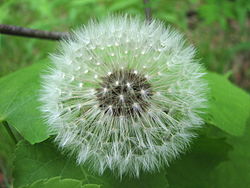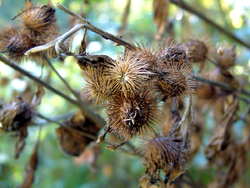Seed dispersal
Seed dispersal is the way seeds get away from the parent plant to a new place. "Dispersal" means to spread or scatter.
The basic idea is as follows. Plants cannot move after they have put down roots. It follows that it is an evolutionary advantage to get their seeds away from the parent plant. If the seeds take root nearby they will compete with each other and the parent plant. Also, a species is more likely to survive when its members are widely spread. This is because local disasters still leave plants in other places.[1]
From the first land plants in the Silurian period for 300 million years to the Lower Cretaceous, virtually all transport of spores and seeds was done by mechanical means. In fact, for most types of plants both fertilisation and dispersal was done by wind. If not wind, then water was the medium.
A great change took place with the appearance of flowering plants in the Cretaceous. The story of flowers and insects is one of the best examples of co-evolution. The gut contents, wing structures, and mouthparts of fossilized beetles and flies suggest that they acted as early pollinators.
The association between beetles and angiosperms during the Lower Cretaceous period led to parallel radiations of angiosperms and insects in the Upper Cretaceous. The evolution of nectar in Upper Cretaceous flowers signals the beginning of the mutualism between hymenopterans and angiosperms.[2]
What is true of fertilisation is also true of dispersal. Spores, the tiny products of lower plants, are almost always dispersed by wind. So are many seeds. Some seeds, and their later development, fruits, are obviously adaptations to a world full of animals. If they are dispersed by being eaten, it is advantageous for them to be nutritious and good to eat. So spores, seeds and fruits may get dispersed mechanically or by animals:
- Mechanical means:
- Spores and seeds dispersed by wind are light, and get blown easily. An extra step is when the spores or seeds are blown out with force.
- Spores and seeds may be fired out by force in some cases.
- Seeds and fruits dispersed by water can float.
- Zoological means:
Mechanical dispersal
Wind dispersal
An important detail for a wind-dispersed seed is that it is very light. It must be able to float easily on wind or else it will drop straight to the ground.[3] There are "parachutes" on top of some seeds, like milkweed and dandelion seeds. Some seeds are very small and light, almost like dust. Orchid seeds and poppy seeds are like that. Poppy seeds are inside a little capsule that has little openings around the top. On a windy day, the poppy fruit capsule will sway from side to side, shaking out the tiny seeds out the windows like a salt shaker.
Another kind of fruit that can be wind-dispersed is the maple tree fruit. The maple tree has little schizocarps, which are two-sided winged fruits. They are also called samaras. Their lightness and "wings" help them stay in the air until they have reached a new place with lots of soil. Elm and birch trees also have samaras.
Explosive action
Some fruits can fling (throw) their seeds away when they are ripe. This is a type of rapid plant movement, where the fruit is thrown from a little "machine".[4]
Pea pods often use mechanical dispersal. When the seeds are ready, the pod dries up. When the pod dries, the inside of the pod dries faster than the outside. This makes the pod twist inside, suddenly splitting open violently, rolling into a little spiral. When this roll happens, it makes the seeds fly out of the pod in all directions.
Impatiens – called "touch-me-nots" or "jewel weeds" – is a large genus of flowering plants. When the seeds are ripe and ready, the dried fruit becomes a trigger. When an animal or human touches the plant, it bursts open and sprays the seeds everywhere. If the ground is wet, the seeds can germinate right where they land; they can also stick to the creature that made the capsule burst open. This can help them be carried off to a new place.
Violets and gorses use mechanical dispersal, too. When the seeds are ready, it opens with a loud "POP!" sound. Another fruit called the squirting cucumber uses mechanical dispersal, too. There are hundreds of other fruits that use mechanical dispersal.
Water dispersal
These plants usually grow near the water. Once the seed falls into the water, it may be carried for a long distance before it finds a place to grow.
A good example is the water lily. Water lilies' beautiful flowers create a fruit that floats in the water for some time and then sinks to the bottom to take root on the floor of a pond. The seeds of the water lily can be dispersed and germinated in the water.
The palm tree, which grows near the water, also disperses its seeds by water. Powerful ocean currents that connect continents move the palm tree's seeds, called coconuts, to their new home.
The mangrove tree lives right in the water. Their seeds fall from the tree and grow roots as soon as they touch soil. If there is a lot of water, they can be carried far away.
Most nuts, like acorns, walnuts, and pecans are dispersed by both water and animals. The main way that they are dispersed by water is during flood times, or if their plants grow near a river or stream. Many nut trees grow near places that flood quite often. Though water is important for nut trees, it's not as important as it is for other plants, because many trees have roots that can grow a long way from the tree to find good soil and water.
Animal dispersal
There are several ways seeds get dispersed by animals.[5] One example are the burrs that stick to your socks and pants when you walk through grassy fields. The parent plant makes the spiky little burrs from the flower. These burrs are either thrown off the plant and onto the ground, or they stay on the plant until a passing animal (or person) gets the burr in its fur, feathers, or socks. Then the burr is carried to a new place, where animals usually try to get it off themselves. Animals gnaw, scratch, or peck at the burrs to get them off. The burr is then dropped on the ground, away from the parent plant. Many grass seeds have surfaces which catch onto passing creatures. For instance spear grass has spiky tips that can get stuck in passing animals or blown by a strong wind to a new place.
Another way for animals to help in seed dispersal is for the animals to actually plant the seeds themselves. Animals like mice, squirrels, and jay birds collect fruits and nuts during the spring and summer, and they store them for the coming winter. Many times, they save up these fruits and nuts by burying them in the ground, often more than they need. When they come to take their fruits and nuts away, they leave a few buried. The ones that are left buried become plants.
Seeds are often dispersed in droppings (poo). Animals swallow fruit (including seeds): they digest the soft fruit, but the seeds come out in their droppings. In some rainforests, almost 90% of tree species are dispersed by animals. Animals like bats – for instance, the short-tailed fruit bat in South America – can scatter up to 60,000 seeds in one night.[6]
Seed Dispersal Media
Epilobium hirsutum seed head dispersing seeds
Wind dispersal of dandelion fruits
Entada phaseoloides – Hydrochory
The small hooks on the surface of a Geum urbanum bur enable attachment of individual hooked fruits to animal fur for dispersion.
Example of epizoochory: Labrador retriever with hooked fruits detached from Geum urbanum burs trapped in fur after running through undergrowth
Epizoochory in Bidens tripartita (Asteraceae); the hooked achenes of the plant readily attach to clothing, such as this shirt sleeve.
Epizoochory in Galium aparine (Rubiaceae): shoelaces covered in velcro-like burs after a woodland walk
Epizoochory in the grass Cenchrus spinifex: burs on clothing after walk on beach
Video of the study car moving along the study road. The car was filmed after new seeds of all species were laid out in front of the zero line. The markings indicating the sections parallel and perpendicular to the direction of traffic (Fig. 1) are visible.
References
- ↑ Ridley, Henry N. 1930. The dispersal of plants throughout the world. Ashford, Kent: Reeve. ISBN 0-85393-004-X
- ↑ Stebbins G. Ledyard, Jr. 1974. Flowering plants: evolution above the species level. Harvard.
- ↑ Gurevitch J; Scheiner S.M., & G.A. Fox 2006. Plant ecology. 2nd ed, Sinauer Associates, Massachusetts.
- ↑ Garrison W.J; Miller G.L. & Raspet R. 2000. Ballistic seed projection in two herbaceous species. American Journal of Botany. 87: 1257-1264.
- ↑ Janson C.H. 1983. Adaptation of fruit morphology to dispersal agents in a neotropical forest. Science 219:187-189.
- ↑ Theodore H. Fleming 2014. Fruit bats: prime movers of tropical seeds. Bat Conservation International 4 April 2014, volume 5, #3.
Other websites
- Fruit and seed dispersal images at bioimages.vanderbilt.edu Archived 2017-04-25 at the Wayback Machine
- Image from Missouri.edu Archived 2015-09-10 at the Wayback Machine














